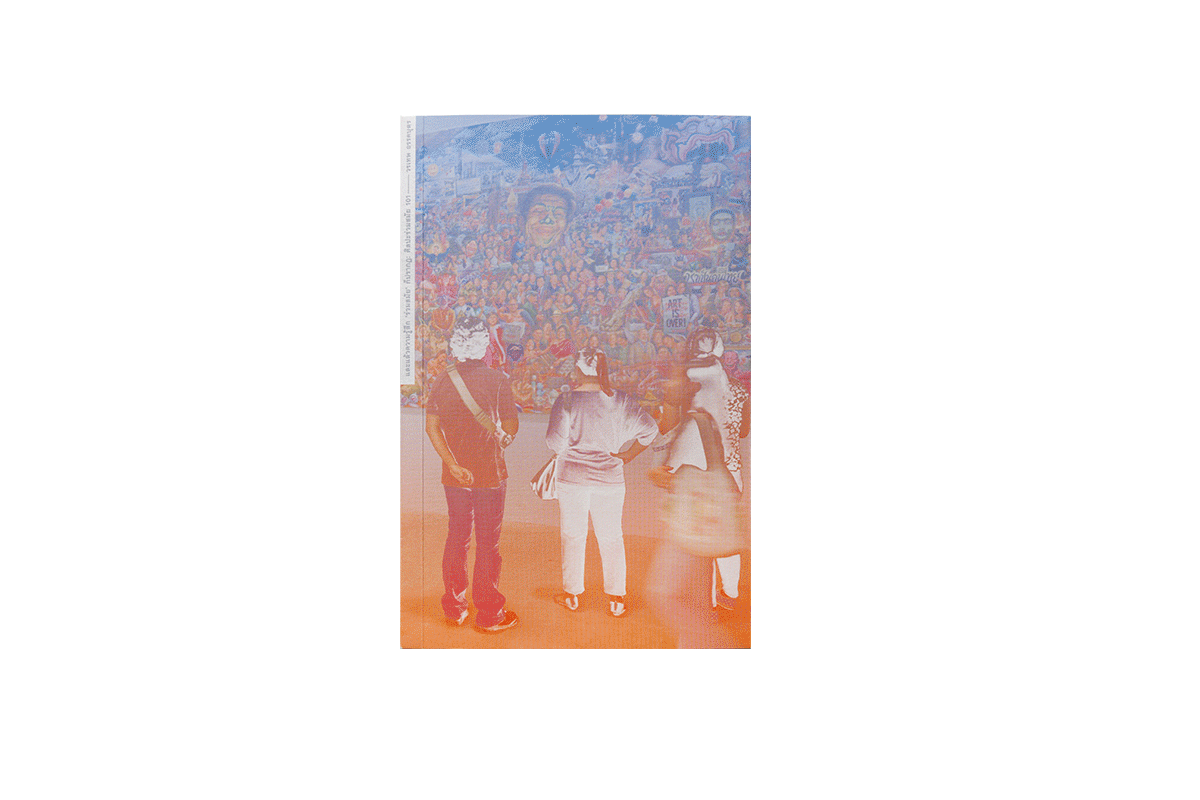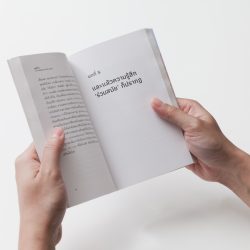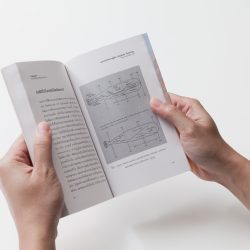“WHAT IS CONTEMPORARY ART?” SOUNDS LIKE A SIMPLE QUESTION BUT IT ISN’T THAT EASY TO ANSWER
While a direct meaning may refer to works of art whose creators are still considered to be a part of the contemporary times (simply speaking— still alive), the use of ‘time’ as the sole criterion can be problematic since that would include every single recent work of art including the ones that are not exactly created from a Contemporary art sensibility. In the meantime, if artistic style were to be used as the point of reference, the contemporary works that borrow their style from traditional works would be excluded.
‘And So The Feeling Of ‘Contemporary’ Has Appeared’ takes off from this particular question as the author, Worathep Akkabootara, uses the 222 pages of the book to take his readers on a journey to explore different definitions of Contemporary art in different areas of the world through other criteria (in addition to time and style) adopted to help categorize what is qualified as a work of Contemporary art and what isn’t. The problem with the word ‘contemporary’ is the implication of ‘modernity’ that is attached to it, making the term more indefinite (compared to the concept of Modern art) and changeable. Another interesting sub-categorization is the art historian, Terry Smith’s analysis of Contemporary art, which divides the artistic genre into Remodernism in which Damien Hirst is included, Transnational Art, and Networked Art—the latter emerges from the development of modern communication technology. Apart from the aforementioned categorization, Akkabootara also includes Smith’s definition of Contemporary art in the book with details that we suggest you have a look at for some interesting insights.
Overall, ‘And So The Feeling Of ‘Contemporary’ Has Appeared’ is a very niche pocket book and it won’t be the top reading choice for those who do not have any unsettling issues with the term ‘Contemporary art.’ However, having read this book we were introduced to a greater number of Thai and international art historians while the 70-page-long reference in which Akkabootara writes about other issues surrounding the definitions is a great resource for those who are interested in pursuing further research.
Worathep Akkabootara
commonbooks, 2018
Paperback, 222 pages, 18.2 x 12 cm
ISBN 978-616-91192-9-6
“ศิลปะร่วมสมัยคืออะไร?” เป็นคำถามที่เหมือนจะง่ายแต่ก็ไม่ง่าย ถ้าแปลแบบทื่อๆ ตรงๆ อาจจะได้ความหมายว่า ศิลปะที่ศิลปินผู้สร้างยังร่วมสมัยอยู่ตอนนี้ (พูดง่ายๆ คือยังมีชีวิตอยู่) แต่การใช้ “เวลา” เป็นเกณฑ์ก็ทำให้เกิดปัญหาตามมา เพราะเท่ากับว่างานศิลปกรรมทุกชิ้น รวมถึงงานที่ไม่ได้เกิดขึ้นมาบนสำนึกแบบศิลปะร่วมสมัยก็จะถูกเหมารวมมาอยู่ในกระแสศิลปะนี้ทั้งหมด กลับกันถ้าใช้รูปแบบผลงานเป็นตัวตั้ง ก็จะทำให้งานศิลปะร่วมสมัยที่หยิบยืมเอาสไตล์งานประเพณีมาใช้โดนตัดออกไป
‘และแล้วความรู้สึก ‘ร่วมสมัย’ ก็ปรากฏ: ศิลปะร่วมสมัย 101’ ตั้งต้นจากคำถามที่ว่านี้ วรเทพ อรรคบุตร ใช้พื้นที่หน้ากระดาษกว่า 222 หน้าของหนังสือเล่มนี้ พาเราไปสำรวจนิยามของศิลปะร่วมสมัยที่เกิดขึ้นในพื้นที่ต่างๆ ทั่วโลก ตั้งแต่ หลักเกณฑ์อื่นๆ ที่ถูกนำมาใช้คัดแยกว่าอะไรเป็นศิลปะร่วมสมัย อะไรไม่ใช่ (ที่มากกว่ากรอบของเวลาและรูปแบบ) ปัญหาของคำว่า “ร่วมสมัย”ที่มีนัยของความ “ทันสมัย” พ่วงมาจนทำให้ขอบเขตของคำว่า “ร่วมสมัย” ไม่นิ่ง (เท่ากับคำว่า “สมัยใหม่”) และเปลี่ยนแปลงได้อยู่ตลอดเวลา รวมถึงการจำแนกกระแสศิลปะร่วมสมัยลงไปอีกชั้นหนึ่ง ที่น่าสนใจคงเป็นการวิเคราะห์ศิลปะร่วมสมัยของนักประวัติศาสตร์ศิลปะ Terry Smith ที่จำแนกศิลปะร่วมสมัยออกเป็น 3 กระแสใหญ่ๆ คือ สมัยใหม่นิยมไหลย้อน หรือ Remodernism (ที่ Damien Hirst ถูกรวมอยู่ในกลุ่มนี้ด้วย) กระแสศิลปะข้ามชาติ หรือ Transnational Art และศิลปะเชิงเครือข่าย (ไม่มีคำแปลเป็นภาษาอังกฤษ) ที่เกิดขึ้นจากการพัฒนาของระบบการสื่อสารสมัยใหม่ นอกจากการจำแนกศิลปะร่วมสมัยที่พูดถึง วรเทพยังยกนิยามของคำว่าศิลปะร่วมสมัยในทัศนของ Smith มารวมไว้ในเล่มด้วย ซึ่งรายละเอียดจะเป็นยังไงคงต้องลองไปเปิดอ่านดูกันเอาเอง
โดยรวมแล้ว ‘และแล้วความรู้สึก ‘ร่วมสมัย’ ก็ปรากฏ: ศิลปะร่วมสมัย 101’ ถือว่าเป็นพ็อกเก็ตบุ๊คที่เฉพาะทางมากๆ ถ้าใครไม่มีประเด็นกับคำว่า “ศิลปะร่วมสมัย” แต่แรกก็อาจจะไม่หยิบขึ้นมาเปิดอ่าน แต่การอ่านหนังสือเล่มนี้จะทำให้เราได้รู้จักนักวิชาการด้านประวัติศาสตร์ศิลปะทั้งในไทยและต่างประเทศมากขึ้นอีกเป็นกอง คุณประโยชน์อีกอย่างที่มองข้ามไม่ได้คือเชิงอรรถท้ายเล่มกว่า 70 หน้า ที่วรเทพเขียนขยายความถึงประเด็นอื่นๆ ที่รายรอบอยู่ และหน้าบรรณานุกรมที่เป็นลายแทงชั้นดีสำหรับผู้ที่สนใจจะค้นคว้าต่อ ถ้ามีเวลาว่างก็อยากให้ลองเปิดอ่านกันดู
TEXT : NAPAT CHARITBUTRA
PHOTO : KETSIREE WONGWAN
fb.com/commonbookspublishing




